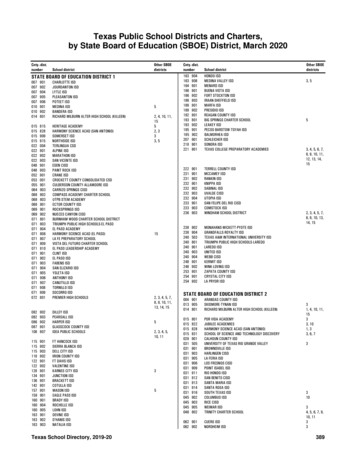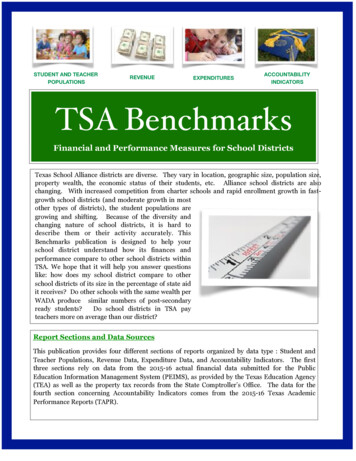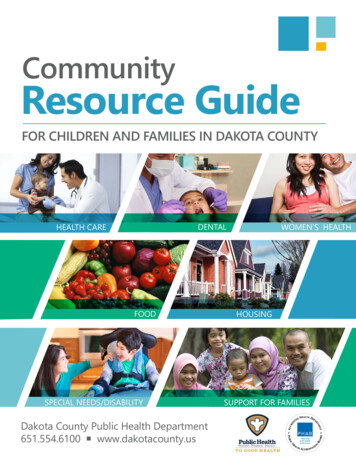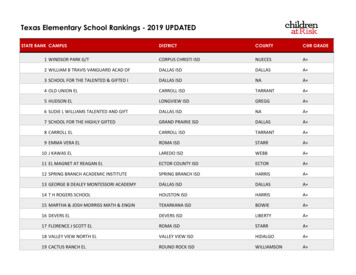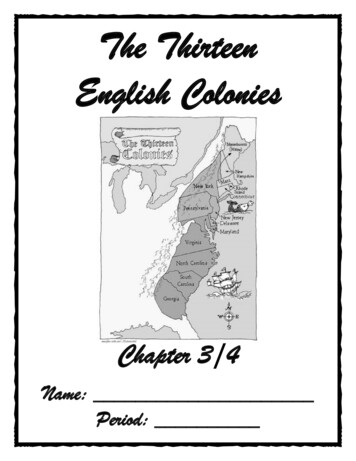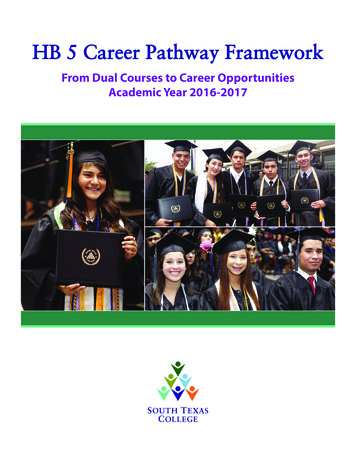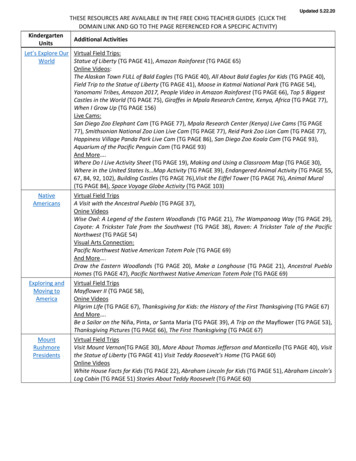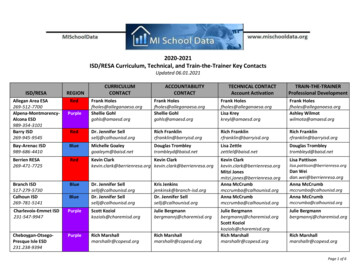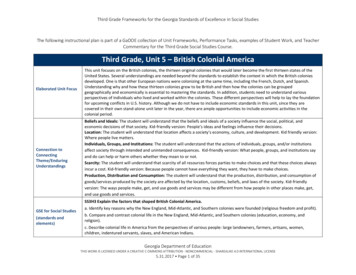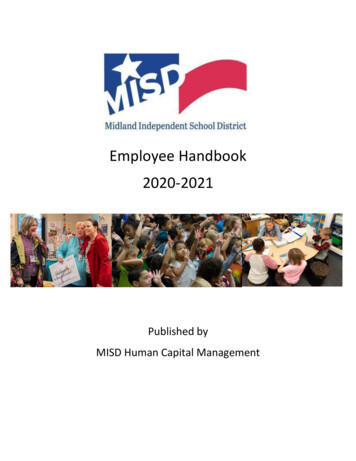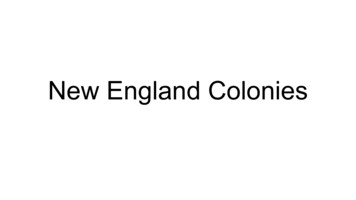
Transcription
New England Colonies
Reading Enrichment TimeSo relax and enjoya book of choice!
The New EnglandColoniesWe will understand the motivationsof people that settled in the NewEngland Colonies.I will create a travel brochurepersuading people to move to the 13colonies.
THE 3 MAIN REASONS FOR EXPLORATION?
Back to the point, different people visit or move to different areas for different reasons.Settlers moved to the 13 colonies for the purpose of religious freedom (God).
LET ME SHOW YOU WHAT I MEAN .
PlymouthPeople looking for religious freedom started a third settlement in North America.In 1620, the Separatists (now known as Pilgrims), sailed to North America on a shipnamed the Mayflower. The Mayflower carried Pilgrims from both England and theNetherlands. The ship landed at Plymouth Bay in what is now Massachusetts. Theylived on the ship for the first few months. The Pilgrim leaders came up with agovernment plan that would help all people live together in a peaceful way. All themen signed the agreement, which we know as the Mayflower Compact. Then theyelected John Carver as governor. Many people think of the Mayflower Compact asAmerica's first example of true self government. It was the first self-government planever put into effect in the English colonies.
The PuritansMost of the people who lived in the NewEngland colonies wanted to create communitieswhere they could practice their own religiousbeliefs feely.Some of the colonist in the region, like thePilgrims of Plymouth, wanted to separatethemselves completely from the Church ofEngland. Other people considered themselvesPuritans. They wanted to continue sometraditions of the English church, but they wantedto have freedom to change or “purify” others.
Think back to yourregions map.What is the name ofthe orange region?What do you thinkthe weather is likethere?
New England ColoniesWhat main ideascan we infer fromthis poem?
Climate It was often difficult to live in theNew England Colonies. Winters inthe region where cold and snowy. The icy winters, discouraged thegrowth of germs that causeddisease. In summer there was plenty ofrain that helped crops grow well.
The Economy of New EnglandMany colonists in this regionmade a living by fishing,shipbuilding or raising animals.Because there were many thickforests in the region, people alsoworked cutting and selling lumber.Ships carried sugar, wool and beefto sell back in England.The Economy of the New EnglandColonies
GeographyIn the New England colonies, the land was rocky and bad for farming (thinsoil), but forested land and fish were both plentiful. People around theworld used lumber to construct ships and buildings.New Englanders also made excellent fishing boats. Fishing becameprofitable. Shipbuilding, lumber, and exporting cod became big industries.
QUICK CHECKDo you remember whyfarming was not a part ofhow they mademoney/trade?
ADD TO YOUR organizer:
Compare your notes with 3 other studentsand see if you can help someone add totheir organizer!Make sure you’re adding to yours, too!
On your own:Complete the New England Colonies graphic organizer. Keep these in your foldersto help you create your travel brochure at the end of the week.When you’re finished: Check Flocabulary assignmentsFinish your Regions andReasons explorers organizerand crosswordHomework #2 is turned inMay Do: Read, Extra Credit Work
Colonial Rule Breakers BanishedFounding Rhode IslandPeople wanted to settle the colonial regions for manyreasons, one of which was religious freedom. Twocolonists learned, though, that true religious freedomwas very difficult to find. They broke rules of thechurch and were punished severely.
Quiz
Anne HutchinsonAnne Hutchinson was also apreacher. She spoke outagainst the Puritan churchbecause she did not agree withthe leaders of the church. Theleaders in Massachusettsaccused her of treason, orbeing against the government.Hutchinson also fled to RhodeIsland.
Roger WilliamsWilliams was a minister inMassachusetts. He did not wanthis church to be like thechurches he left in England. Hewanted the government and thechurch to be separate. Williamsran away to live with AmericanIndians. Later, he moved toRhode Island and founded thecity of Providence.
New England Colonies quiz in Google classroom. Next, independent unfinished work.
The Middle ColoniesWe will understand the motivations of peoplethat settled in the Middle Colonies.I will compare and contrast the differencesbetween the New England and MiddleColonies.
Today, we’re going to talk about why people decided to settle in the Middle Colonies. Butfirst, can you remember who the 2 groups of people were who settled in the New Englandcolonies and WHY they settled there?
Back to the point .The Middle Colonies shared some similarities and differences with the New England Colonies.Let Me Show You What I Mean .NOTE: As we work today, complete your graphic organizer over theMiddle Colonies.
The Middle ColoniesAre “pennd” in the middle of the 13 colonies.New YorkPennsylvaniaNew JerseyDelaware
Pennsylvania and DelawareThe rest of the Middle Colonies were foundedby a man named William Penn. The Quakers weretolerant of other religions. They believed thateveryone was equal. Like other religiousgroups, the Quakers were persecuted in England.Penn’s father had loaned money to the king. When his fatherdied, William asked King Charles II to pay this debt with landin North America. The king gave William a large piece, westof New Jersey and southwest of New York. William namedthis land Pennsylvania, which means “Penn’s Woods.” Hefounded a colony where Quakers—and everyone else—couldworship freely. His main reason for founding Philadelphia,Pennsylvania was for religious freedom.
What do you notice about William Penn and thestate Pennsylvania?
What do you notice about William Penn and thestate Pennsylvania?Why do you thinkhe did this?
Peace and DiversityWilliam Penn interacted with Native Americans differently than mostEnglish settlers. He signed a peace treaty with the Lenni Lenape and paidthem for their lands. Penn welcomed Native American refugees from othercolonies, too. The colony was peaceful for a very long time because of this.Penn also granted equality to people of all religions and even to people ofother European countries. Pennsylvania soon had asmuch ethnic and religious diversity asNew York and New Jersey. Diversity isthe condition of having people who aredifferent in some way living orworking together in the same place.
DelawareIn 1704 the lower three counties asked WilliamPenn for the right to make their own laws. Hegranted their request. The land was still part ofPennsylvania, but the people who lived therecalled it Delaware. Over time, Delaware came tobe thought of as its own colony.
What is a similarity that you can think of so farbetween the New England Colonies and theMiddle Colonies?The New England and Middle Colonies are similar (alike) because they both .
Economy in the Middle ColoniesLand in the Middle Colonies was good forfarming. Colonists there grew wheat andraised livestock, such as dairy cows. Peoplein New York City and Philadelphia neededproducts made from wheat and milk. Withthe countryside able to support their needs,people in cities made other goods.Printers, shoemakers, carpenters, and other craft workers openedshops in those cities. New York and Philadelphia both hadexcellent inland ports. Traders shipped goods from the MiddleColonies to other colonies and the rest of the world.
EconomyNews of economic opportunity in thecolonies spread quickly to people stillliving in Europe. Many of thesepeople jumped at the chance to settlewhere they might make lots of money!The Middle Colonies of New York, Pennsylvania, New Jerseyand Delaware filled with people from all over Europe.German, Irish and English citizens hoped to get wealthy andhave religious freedoms.
Climate & GeographyThe climate of the Middle Colonies was milder thanthat of the New England Colonies. Winters werestill cold, but they did not last as long. Summerswere hot and rainy.This meant there was a longer growing season.Because of this and very fertile (rich) soil, framerscould successfully grow a variety of crops.They farmed wheat grain, rye, tobacco, corn andother vegetables.
Climate & GeographyBecause wheat, grain and corn were grown on alarge scale in the Middle Colonies, this region wasalso called “the Breadbasket.” It was also commonfor indentured servants, or slaves, to help harvestcrops in the Middle Colonies.
What is a difference that you can think of so farbetween the New England Colonies and theMiddle Colonies?They are different because the New England colonies and the Middle colonies .
On Your Own: Complete the sentence frame comparing and contrasting thecolonies.A similarity I see between the New England and Middle Colonies is . A differencebetween them is .
There was a lot to do for work in theMiddle Colonies. Merchants oftentraded crops and furs across theAtlantic. They relied on waterwaysto help ship their goods. Miners dugup iron from the ground to trade. So,there were plenty of jobs for anyonewilling to work in this region.People in the Middle Colonies did nothave much say about how officialsran their governments. In New York,for example, England’s royalty
ADVISORY CLASS:Grab your chromebooks.Find a seat.Please do not movearound the room.You may talk AFTER the announcements areover but STAY SEATED.
Reading Enrichment TimeSo relax and enjoya book of choice!
FICTION RESPONSEWhat is the title of this text?Where/when does the story takeplace? How do you know?NONFICTION RESPONSE
The Southern Colonies
The Southern ColoniesWe will understand the motivationsfor settling the southern colonies.I will explain why the southerncolonies were established.
Intro to the Southern Coloniesvideo 237f93-88f2-489b-b593-5df425ede178
The Southern Colonies
The Southern ColoniesThe Southern Colonies had mild winters and long hotsummers. This was just the right climate for farmers toproduce plentiful crops of tobacco, rice and indigo. Theysold these cash crops to make lots of money. Farmowners needed many helpers to tend their large farmscalled plantations. Over time, many slaves worked onthese farms. Besides farming, people in the SouthernColonies earned money by shipping, fishing, cuttinglumber and trading with American Indians.
Video – The Slave Plantations ofcolonial st false
The Southern ColoniesColonists had limited input into government in theSouthern Colonies. The founders often held greatcontrol. After a while, the colonies electedassemblies, but only white men who ownedproperty could vote in the elections. In Georgia, theKing of England could revoke, or take back, any lawthe assembly passed.
Today, we will review theeconomy, geography andimportant people of the 13colonies.BUT FIRST,If you could live in the New England, Middle, or Southern colonies,which one would you choose and why?
Great discussion!I would choose the Southern colonies because of the mild climate!Back to the point, time for review!With your table teams, you will match the land, climate andeconomy characteristics with its correct colony.
13 colonies review
On your own:When you finish,work on all unfinishedindependent work.Check Skyward for anymissing grades.Check your folders forany work you may haveforgotten to turn in!Directions: Base your answers to the following questions on the chart seen above andyour knowledge of social studies. Please answer in complete sentences.1. What are the three colonial regions?2. Why might the New England region make its money by doing things other thanfarming?3. Explain a difference you notice about the crops grown in the Middle region andsome of the crops grown in the Southern region.4. Why might the New England region be more successful than the Southern region atfishing, whaling, shipbuilding, and lumbering?5. Based on the chart and what else you have learned, explain how geography canaffect the economy or way people make money.
Objective of assignment:To persuade colonists to move to the 13 colonies.Use your journal notes, organizers, and research from this week to create your brochure of the 13colonies.DUE Monday, Sept. 23rd.Use the provided long white pieces of copy paper to create your brochure AFTER YOU HAVECOMPLETED YOUR RESEARCH FROM THE FOLLOWING SLIDES AND RECORDED YOUR NOTESIN YOUR JOURNALS.These may taken home for completion.
Thursday/Friday/MondayToday we will expand our knowledge on the 13 colonies.You will create a travel brochure to persuade colonists to settle in one of the 13 colonies.BUT FIRST . Have you ever seen apicture of a place or read somethingabout a place and thought,“I want to go there!”?
Back to the point. Travel brochures can be a useful tool to learninformation about a place that you are interested in exploring.So today, you will begin a travel brochure that highlights yourknowledge of the 13 colonies that we’ve been exploring all week!Let Me Show You What I Mean .
Most travel brochures have some type of slogan, or catch-phrase that makes a place seem irresistible!
Let’s braindump some GREAT things that welearned about the 13 colonies!
In your journal, create 3 “slogans” that you think areCATCHY and that will persuade people to want to golive in or visit the 13 colonies.New EnglandMiddleSouthernCatch phraseCatch phraseCatch phrase
Your slogans for each of the colonies!
Let’s Research some more about the Geography and Climateof the New England Colonies!!! JOINPD.COMWhat’s your slogan? (For example, “Cold colonies mean no germs here!”)Climate/Geography Go to: http://mrnussbaum.com/new-england-colonies/A) Draw or trace a small map of the New England Colonies on yourPanel. (do this for your final draft, right now we’re researching!)B) Describe the climate of the New England Colonies.C) What was the soil like in the New England Colonies? What effectwould this have on farming?D) How would cold winters benefit someone moving to the New EnglandColonies?
Objective of assignment:To persuade colonists to move to the 13 colonies.Use your journal notes, organizers, and research from this week to create your brochure of the 13colonies.DUE Monday, Sept. 23rd.Use the provided long white pieces of copy paper to create your brochure AFTER YOU HAVECOMPLETED YOUR RESEARCH FROM THE FOLLOWING SLIDES AND RECORDED YOUR NOTESIN YOUR JOURNALS.These may taken home for completion.
Thursday/Friday/MondayToday we will expand our knowledge on the 13 colonies.You will create a travel brochure to persuade colonists to settle in one of the 13 colonies.BUT FIRST . Have you ever seen apicture of a place or read somethingabout a place and thought,“I want to go there!”?
Back to the point. Travel brochures can be a useful tool to learninformation about a place that you are interested in exploring.So today, you will begin a travel brochure that highlights yourknowledge of the 13 colonies that we’ve been exploring all week!Let Me Show You What I Mean .
Most travel brochures have some type of slogan, or catch-phrase that makes a place seem irresistible!
Let’s braindump some GREAT things that welearned about the 13 colonies!
In your journal, create 3 “slogans” that you think areCATCHY and that will persuade people to want to golive in or visit the 13 colonies.New EnglandMiddleSouthernCatch phraseCatch phraseCatch phrase
Your slogans for each of the colonies!
Journal: Answer all of the questions about each colony in your journal and record your answers in your journal.Then, begin creating your brochure.
Monday: sub plans:Continue working on travel brochure. If finished, flocabulary assignment.
Tuesday: Common AssessmentSpeed review, table hopping with travel brochure .review 13 colonies
The Economy of New England Many colonists in this region made a living by fishing, shipbuilding or raising animals. Because there were many thick forests in the region, people also worked cutting and selling lumber. Ships carried sugar, wool and beef to sell back in England. The Econ
